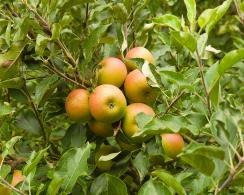Malus Domestica Jonagold Dessert Apple Tree
Popular & Successful Apple Variety suited to growing in Northern Europe
1. Add items to basket
2. Go to the basket
3. Enter your postcode in Delivery Price Check
Plant shape: Full standard
Trunk height: 1.6-1.8 m
Trunk girth: 8-10 cm
Rootball - supplied without a pot
Plant ID: 14816 100
Plant shape: Full standard
Trunk height: 1.8-2 m
Trunk girth: 14-16 cm
Rootball - supplied without a pot
Plant ID: 14817 100
To check delivery cost add your plants to basket, then you can type your postcode in our Quick Delivery Price Check.


RHS AGM-winning Malus Domestica Jonagold Apple Tree is a smooth-skinned, honey-scented dessert apple with juicy yellow flesh. This deciduous fruit tree suits medium to large-sized gardens.
An American variety, bred in 1943, Jonagold is the offspring of Golden Delicious and Jonathan, hence its name. Its sweet and juicy Golden Delicious heritage is tempered by Jonathan’s tart flavour, so it’s perfect for lovers of sweet but tangy high-quality apples.
Jonagold dessert apple trees produce white-pink blossom in April and May followed by a large crop of orange-red flushed, or red over gold striped, apples with russet freckles in late October. As well as tasting delicious, Jonagold is a handsome ornamental tree that complements both countryside and urban gardens.
This is a popular dessert apple that suits northern Europe’s climate, which is unusual for Golden Delicious varieties.
Height and Spread of Malus Domestica Jonagold
A regular Jonagold Apple Tree reaches around 5-7 metres tall with an upright broad crown.
How Hardy Is Malus Domestica Jonagold
Fully hardy in the UK if its roots are well drained and it's situated in full sun. Its blossom arrives in April to May, which misses the majority of frosts.
How To Use Malus Domestica Jonagold
This is an attractive fruiting tree for wildlife gardens because its blossom tempts bees and its windfall apples feed fruit-loving birds like thrushes.
Its apples are dual-purpose. They’re good straight from the branch or cooked in pies, jams, and jellies. They store exceptionally well for up to six months and they’re suitable for freezing or dehydrating.
Jonagold dessert apple is a triploid apple in group 4. For the heaviest crops it needs two pollinating partners (or one self-fertile variety) that bloom in April and May. For example, Cox's Pomona and or the lovely Winston Apple.
How To Care for Malus Domestica Jonagold
Choose a sheltered spot with free-draining soil and full sun. Jonagold likes fertile soil and an annual application of well-rotted organic matter to help boost its health throughout the year. Keep it well-watered for at least 12 months.
In midwinter’s dormant season, prune all dead, damaged, or crossed branches and cut back the previous year’s growth by one-third. Cut just above an outward-facing bud to encourage fruiting spurs.











